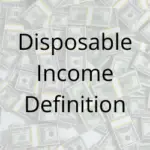Table of Contents ![]()
Disposable Income: Definition & Examples
What is Disposable Income
Disposable income is the income consumers receive after taxation. For example, if consumers receive $2,000 in wages a month, $500 of that may come out in taxation. After that, they receive $1,500 in ‘disposable income’. In other words, they can then use that income for whatever they like or need.
It is easy enough to get disposable income and discretionary income confused for one another. Whilst disposable income is the income we receive after tax – discretionary income is that we receive after tax AND after necessities are paid for such as food, housing, water, utilities, and clothing.
Key Points
- Disposable income is the income consumers receive after tax has been taken out.
- It differs from discretionary income which is the income after tax as well as other necessities such as food, shelter, water, and utilities.
- In the US, disposable income also includes deductions for ‘wage garnishments’ such as debt repayments or child support.
- Disposable income doesn’t include voluntary deductions such as pension contributions or transport deductions.
Once all legal taxes have been removed such as; federal, state, local, state unemployment, disability, social security, and other garnishments or levies – disposable income is what is leftover. However, it does not include voluntary contributions such as that for retirement or transport deductions. In turn, the level of disposable income will vary from nation to nation and state by state – depending on the tax regime.
Disposable Income Formula
Let us say that Mr. Gregory works at a manufacturing plant and earns an annual salary of $40,000. If the Federal tax rate is 10 percent, he would pay $4,000 in taxes. On top of this, there may be other deductions such as a 5 percent state tax at $2,000 and a 10 percent tax for social security at another $4,000. So in total, Mr. Gregory pays $10,000 in taxes. When we take this away from his income, he is left with $30,000.

Why is Disposable Income Important?
Disposable income is an important economic concept as it is one of the key determinants of consumer demand. As income increases, it means consumers have more money to spend in the economy. For policymakers, this is important because higher disposable incomes can prove beneficial to the health of the economy and employment, but a decline could signal a slowdown in the economy.
If tax rates remain the same, but disposable income starts to decline, it usually suggests that people are losing their jobs, taking pay cuts, or, working fewer hours. All of which signals a wider economic issue. With workers taking home less money or becoming unemployed completely, the demand for goods in the wider economy will fall. For instance, someone who has just been made redundant may need to cut back on luxuries such as weekend vacations.
Falling disposable incomes can suggest a wider economic issue. More importantly, the data is more reliable and more frequently available than other sources. For instance, unemployment statistics rely on survey data which is not 100 percent accurate. We also have other economic measures such as GDP and inflation which are measured quarterly – so lag behind.
As a result, disposable income is a useful indicator that can highlight when the economy is slowing down. In turn, policymakers may use this to introduce new policies to provide an economic stimulus. For instance, lowering taxes would help boost income and create the necessary demand for the economy.
Disposable Income Examples
As we look at a few examples, let us just remind ourselves that disposable income is the net income received after tax. However, in the US, it also includes what is known as ‘wage garnishment’. This is a legal procedure whereby part of the employees’ wages is taken in order to pay off a debt or child support. So in the US, disposable income not only includes taxes but also ‘wage garnishments’.
Example #1
Louise works as a baker in New York. She earns $30,000 a year before tax. She pays $2,000 in Federal taxes, $1,500 in state taxes, and $2,000 in social security. In total, these taxes amount to $5,500. Once we subtract that away from her gross salary, we reach $24,500.
Example #2
Bob works as a finance officer in San Francisco, earning $80,000 a year before tax. He pays $7,000 in Federal taxes, $4,000 in state taxes, and $7,000 in social security. In addition, he also has a ‘wage garnishment’ of $1,000 that is due under child support. So in total, he pays $19,000 in taxes and child support – leaving him with $61,000.
Example #3
Ryan works as a bus driver in Ohio, earning $50,000 a year before tax. He pays $4,500 in Federal taxes, $3,000 in state taxes, and $4,500 in social security. On top of that, he pays $3,000 in pension contributions. In total, he pays $12,000 in taxes and $3,000 towards his pension. However, pension contributions are voluntary, so are therefore not considered under disposable income. Therefore, only $12,000 is deducted from the gross income of $50,000 – leaving Ryan with $38,000.
Discretionary Income vs Disposable Income
The difference between disposable and discretionary income is that discretionary income derives from disposable income. It refers to disposable income, but minus any necessary expenditures such as housing, food, electricity, gas, and water. Only once these have been paid, alongside tax, are we left with discretionary income.
Related Topics
FAQs
It consists of all forms of income minus tax.
Louise works as a baker in New York. She earns $30,000 a year before tax. She pays $2,000 in Federal taxes, $1,500 in state taxes, and $2,000 in social security. In total, these taxes amount to $5,500. Once we subtract that away from her gross salary, we reach $24,500.
It is important as it is a leading economic indicator. A fall in the nations disposable income may signal an oncoming recession which may require interventionist policies.
Further Reading
 Disposable Income: Definition & Examples - Disposable income is the income we receive after taxation.
Disposable Income: Definition & Examples - Disposable income is the income we receive after taxation.  Economic Efficiency - Economic efficiency refers to the optimal allocation of resources to maximize overall welfare or output.
Economic Efficiency - Economic efficiency refers to the optimal allocation of resources to maximize overall welfare or output.  Present Value: Definition, Criticisms & Example - Present value (PV) is the current value of a future sum of money, or stream of revenue. Tihs is calculated…
Present Value: Definition, Criticisms & Example - Present value (PV) is the current value of a future sum of money, or stream of revenue. Tihs is calculated… 
